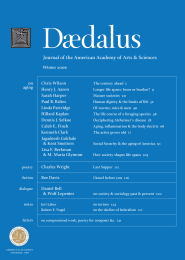Facing our limits: human dignity in the very old
An ancient Greek myth captures a dilemma that still faces us today. The goddess of the Dawn, Eos, persuades Zeus to make her earthly lover Tithonus immortal. But she forgets to ask Zeus to preserve the health and vitality of her lover. As a result, though Tithonus lives on and on, his body and mind begin to fail. Finally, and with pain in her heart, Eos moves her former lover into a separate chamber where he lives forever out of sight.
Like Eos in the myth, some scholars now entertain the prospect of an indeterminate, if not ‘limitless,’ human life span.1 But should this dream become a reality, still other students of aging foresee a growing number of Tithonuses– very old and frail people, bereft of mind, body, and human dignity.
The Janus face of aging becomes apparent when we compare what, pursuant to earlier work by Bernice Neugarten and Peter Laslett, my colleagues and I have called the ‘Third’ and ‘Fourth Age’ of the human life span.2 These are dynamic and heuristic concepts, approximations that change with time and exhibit large individual variations. Currently, in developed countries, the Third Age begins, on average, at about age 60; the Fourth Age generally starts around age 80.
In recent decades, a powerful coalition of gerontological scientists, policymakers, and social-technological advances has contributed to major increases in longevity and improvements in the quality of life for individuals in the Third Age.3 But theoretical and empirical evidence suggests that further improvement may become more difficult as more and more people reach the Fourth Age. These oldest-old are manifesting a new level of biocultural incompleteness, vulnerability, and unpredictability in their everyday behavior–testing the limits of human functioning as well as of science and policy.
. . .
Endnotes
- 1J. Oeppen and J. W. Vaupel, “Broken Limits to Life Expectancy,” Science 296 (5570) (May 10, 2002): 1029 –1031.
- 2P. B. Baltes, “On the Incomplete Architecture of Human Ontogeny: Selection, Optimization, and Compensation as Foundation of Developmental Theory,” American Psychologist 52 (4) (April 1997): 366–380; P. B. Baltes and K. U. Mayer, eds., The Berlin Aging Study: Aging from 70 to 100 (New York: Cambridge University Press, 1999); P. B. Baltes and J. Smith, “New Frontiers in the Future of Aging: From Successful Aging of the Young Old to the Dilemmas of the Fourth Age,” Gerontology 49 (2) (March/ April 2003): 123–135.
- 3P. B. Baltes and M. M. Baltes, eds., Successful Aging: Perspectives from the Behavioral Sciences (New York: Cambridge University Press, 1990); Baltes and Mayer, eds., The Berlin Aging Study; M. W. Riley, R. L. Kahn, and A. Foner, Age and Structural Lag: Society’s Failure to Provide Meaningful Opportunities in Work, Family, and Leisure (New York: J. Wiley, 1994); J. W. Rowe and R. L. Kahn, “Human Aging: Usual and Successful,” Science 237 (4811) (July 10, 1987): 143–149.
